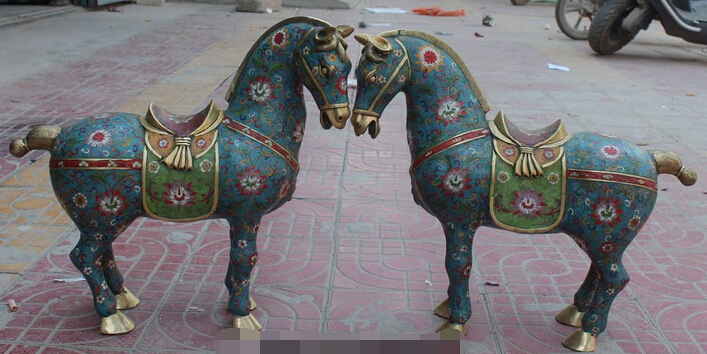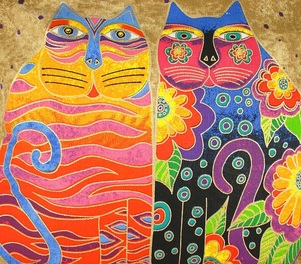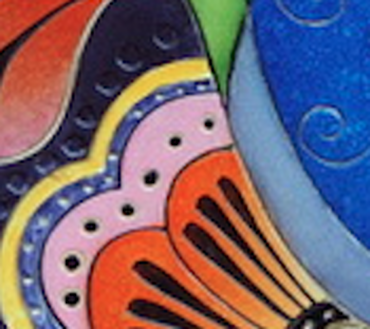Cloisonne Animals
When you have completed your art piece, take a photo of your finished art and turn it in to Canvas
What is Cloisonné?
Watch the 3 videos above (You only need to watch until the 2:18 mark on the Laurel Burch video.). Read the information below. Tell 2 people something you learned from the reading.
Cloisonné is the technique of creating designs on metal vessels with colored-glass paste placed within enclosures made of copper or bronze wires, which have been bent or hammered into the desired pattern. Known as cloisons (French for “partitions”), the enclosures generally are either pasted or soldered onto the metal body. The glass paste, or enamel, is colored with metallic oxide and painted into the contained areas of the design. The vessel is usually fired at a relatively low temperature, about 800°C. Enamels commonly shrink after firing, and the process is repeated several times to fill in the designs. Once this process is complete, the surface of the vessel is rubbed until the edges of the cloisons are visible. They are then gilded, often on the edges, in the interior, and on the base.
Cloisonné objects were intended primarily for the furnishing of temples and palaces, because their flamboyant splendor was considered appropriate to the function of these structures but not well suited to a more restrained atmosphere, such as that of a scholar’s home. http://www.metmuseum.org/toah/hd/clos/hd_clos.htm
Cloisonne originated in Beijing, and the technique reached its perfection as a result of the efforts of Chinese artisans. Chinese Cloisonne is now the standard by which the quality and beauty of Cloisonne is measured worldwide. It ranks as one of China's major contributions to the world's fine arts. http://www.china-tour.cn/Chinese-Arts/Chinese-Cloisonne.htm
Laurel Burch
Laurel was a self-taught painter. She saw herself as a folk artist, telling stories. “In our fast-paced, changing world,” she said, “we need symbols that are a reminder of the ongoing world of the spirit.” On some level, her work was always about bringing different cultures together, and about our connection with the earth and all living things, ideas that have only increased in relevance today. Laurel was always incredibly prolific. Even during her long periods of convalescence, when she was forced to paint from a bed or wheelchair, she seldom put her brushes down. Laurel said, “I refuse to have anything in my life that I can’t turn around into something magical and beautiful. I just refuse.” Her art will forever convey a sense of joy and passion and lightness. There is an inner strength in her figures, with their bold lines and sinuous curves, and something irrepressible in the explosion of her colors. The universe of her imagination was fertile, burgeoning, uplifting, egalitarian, a place where every flower and dragonfly was transformed into something...magical and beautiful. http://www.laurelburch.com/about.html
She was inspired by the cloisonné work she saw in China. You can see a resemblance to the copper outlines in her paintings.
Project Concept
For this project we will be combining the Chinese art form of cloisonné, Laurel Burch's paintings, and the use of animals, bright colors, and patterns that are commonly found in folk art from many cultures.
Research
Watch the 3 videos above (You only need to watch until the 2:18 mark on the Laurel Burch video.). Read the information below. Tell 2 people something you learned from the reading.
Cloisonné is the technique of creating designs on metal vessels with colored-glass paste placed within enclosures made of copper or bronze wires, which have been bent or hammered into the desired pattern. Known as cloisons (French for “partitions”), the enclosures generally are either pasted or soldered onto the metal body. The glass paste, or enamel, is colored with metallic oxide and painted into the contained areas of the design. The vessel is usually fired at a relatively low temperature, about 800°C. Enamels commonly shrink after firing, and the process is repeated several times to fill in the designs. Once this process is complete, the surface of the vessel is rubbed until the edges of the cloisons are visible. They are then gilded, often on the edges, in the interior, and on the base.
Cloisonné objects were intended primarily for the furnishing of temples and palaces, because their flamboyant splendor was considered appropriate to the function of these structures but not well suited to a more restrained atmosphere, such as that of a scholar’s home. http://www.metmuseum.org/toah/hd/clos/hd_clos.htm
Cloisonne originated in Beijing, and the technique reached its perfection as a result of the efforts of Chinese artisans. Chinese Cloisonne is now the standard by which the quality and beauty of Cloisonne is measured worldwide. It ranks as one of China's major contributions to the world's fine arts. http://www.china-tour.cn/Chinese-Arts/Chinese-Cloisonne.htm
Laurel Burch
Laurel was a self-taught painter. She saw herself as a folk artist, telling stories. “In our fast-paced, changing world,” she said, “we need symbols that are a reminder of the ongoing world of the spirit.” On some level, her work was always about bringing different cultures together, and about our connection with the earth and all living things, ideas that have only increased in relevance today. Laurel was always incredibly prolific. Even during her long periods of convalescence, when she was forced to paint from a bed or wheelchair, she seldom put her brushes down. Laurel said, “I refuse to have anything in my life that I can’t turn around into something magical and beautiful. I just refuse.” Her art will forever convey a sense of joy and passion and lightness. There is an inner strength in her figures, with their bold lines and sinuous curves, and something irrepressible in the explosion of her colors. The universe of her imagination was fertile, burgeoning, uplifting, egalitarian, a place where every flower and dragonfly was transformed into something...magical and beautiful. http://www.laurelburch.com/about.html
She was inspired by the cloisonné work she saw in China. You can see a resemblance to the copper outlines in her paintings.
Project Concept
For this project we will be combining the Chinese art form of cloisonné, Laurel Burch's paintings, and the use of animals, bright colors, and patterns that are commonly found in folk art from many cultures.
Research
Websites
Explore both cloisonné and the work of Laurel Burch on line. Use the websites below or do your own research online.
Laurel Burch Art Gallery
Animal Line Art
Chinese Cloisonne Examples
Animal Line Drawing
Generating Ideas
Brainstorm ideas for your project including patterns, animals, colors, etc. Write down 10 ideas that may work for your project.
Visual Development
Test Pattern
Start by creating a test pattern. Below is a close up image from one of Laurel Burch's paintings. On the 6" square provided, paint the pattern trying to match the colors and layout. You are trying to repeat the image as close as possible. Use the tools provided to duplicate the dots.
Once you have completed the sample, take a photo and submit it in Canvas
Explore both cloisonné and the work of Laurel Burch on line. Use the websites below or do your own research online.
Laurel Burch Art Gallery
Animal Line Art
Chinese Cloisonne Examples
Animal Line Drawing
Generating Ideas
Brainstorm ideas for your project including patterns, animals, colors, etc. Write down 10 ideas that may work for your project.
Visual Development
Test Pattern
Start by creating a test pattern. Below is a close up image from one of Laurel Burch's paintings. On the 6" square provided, paint the pattern trying to match the colors and layout. You are trying to repeat the image as close as possible. Use the tools provided to duplicate the dots.
Once you have completed the sample, take a photo and submit it in Canvas
After researching cloisonné Art and Laurel Burch, please create 3 or 4 quick sketches of different ideas. This is the planning stage so all ideas can be modified. Some ideas include animals, plants and flowers, people, and pure design. The style should be playful and simplified. These are not realistic drawings. Her designs include one individual image, 2 or 3 images, or a whole bunch of images. They may be sitting or laying down or jumbled in all types of directions. Check out the examples at the bottom of this page for ideas.
Background Ideas - some of her background are a solid color, others have a small repeated pattern all over, and some are totally filled with her images so that no background shows at all
Patterns - Since the animals, etc are so simple, Laurel Burch filled them with all kind of patterns. You will need to include patterns in your simplified drawings.
Plan colors at this time. There is no limited on how many colors you should use since her designs are full of color. Some of the colors can fade to a darker or lighter version of it's self and others can have a muted texture. You can use a sponge to mush two versions of one color together or press saran wrap into the wet paint and slightly wrinkle it up. Pull the wrap off to leave a pattern.
Final Design
This is the final product. The directions are listed below. If you have a brilliant idea that reflects cloisonné art but doesn't follow the criteria, see me and we can discuss how we can make it happen.
Final Drawing
Paper Options
Your design may be placed on white paper or black paper. The white paper will make your colors clear and bright. The black paper will mute the colors slightly but set an interesting mood. Experiment on scrap paper before you decide. Make sure you base coat colors with white primer if you are painting on black paper. The black paper takes a little work but the final effect is worth it.
Directions
Go back over your work and look for areas that need improvement. This would includes things like erasing pencil lines, fixing painting mistakes, etc.
Background Ideas - some of her background are a solid color, others have a small repeated pattern all over, and some are totally filled with her images so that no background shows at all
Patterns - Since the animals, etc are so simple, Laurel Burch filled them with all kind of patterns. You will need to include patterns in your simplified drawings.
Plan colors at this time. There is no limited on how many colors you should use since her designs are full of color. Some of the colors can fade to a darker or lighter version of it's self and others can have a muted texture. You can use a sponge to mush two versions of one color together or press saran wrap into the wet paint and slightly wrinkle it up. Pull the wrap off to leave a pattern.
Final Design
This is the final product. The directions are listed below. If you have a brilliant idea that reflects cloisonné art but doesn't follow the criteria, see me and we can discuss how we can make it happen.
Final Drawing
- Draw your final design on newsprint. It will be transferred to your final paper.
- Add a thick line around all of your shapes and designs, as well as, outlining your image to mimic the look of cloisonné.
- Draw to scale. This should be the final size.
- If you are using white paper, you can place your drawing underneath the final paper to transfer the image.
- Draw lightly.
Paper Options
Your design may be placed on white paper or black paper. The white paper will make your colors clear and bright. The black paper will mute the colors slightly but set an interesting mood. Experiment on scrap paper before you decide. Make sure you base coat colors with white primer if you are painting on black paper. The black paper takes a little work but the final effect is worth it.
Directions
- Transfer your final design drawing lightly
- Begin filling in your sections with paint. (If you are painting on black paper, use primer first)
- If you are adding a pattern to to a section, lightly draw the shape on the painted section then paint. If the base color is really dark, you will need to base coat to place lighter colors on top of it
- You can also use gold or silver acrylic to your design or you can use metallic paint for your outlines.
- Continue adding colors and patterns until the painting is filled. Even if an area is white, you should paint it white rather than leaving it plain paper,
Go back over your work and look for areas that need improvement. This would includes things like erasing pencil lines, fixing painting mistakes, etc.



